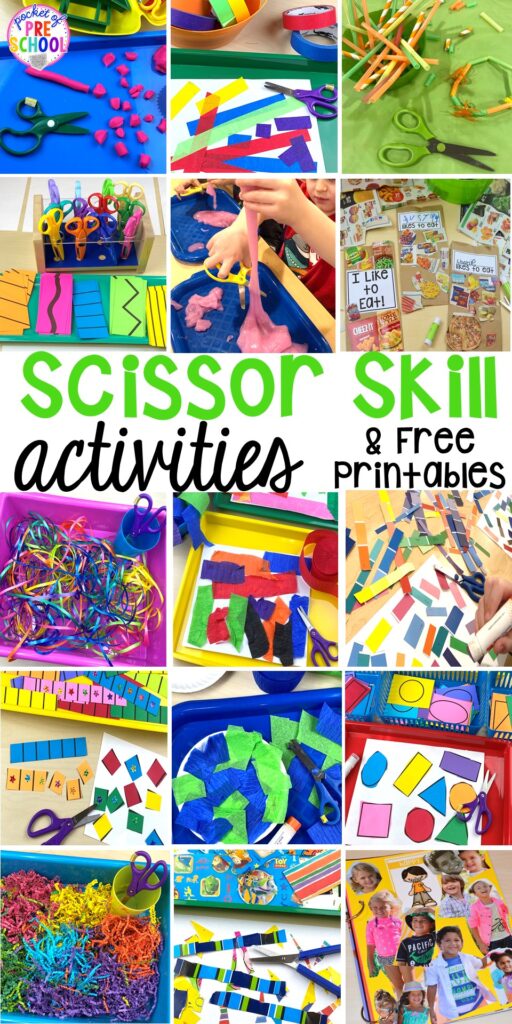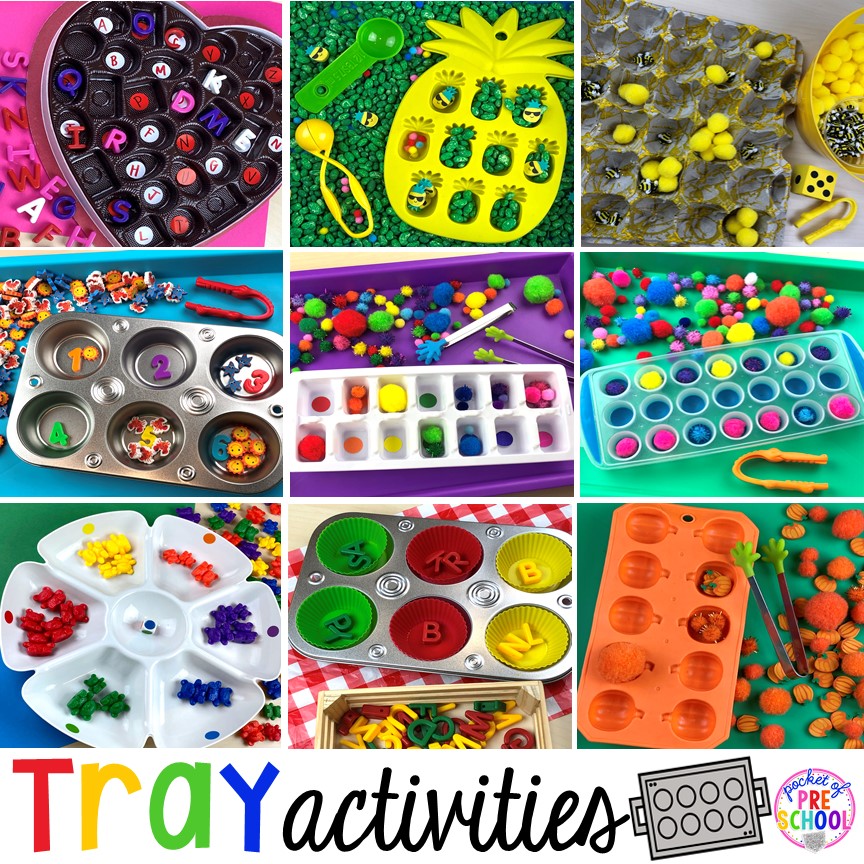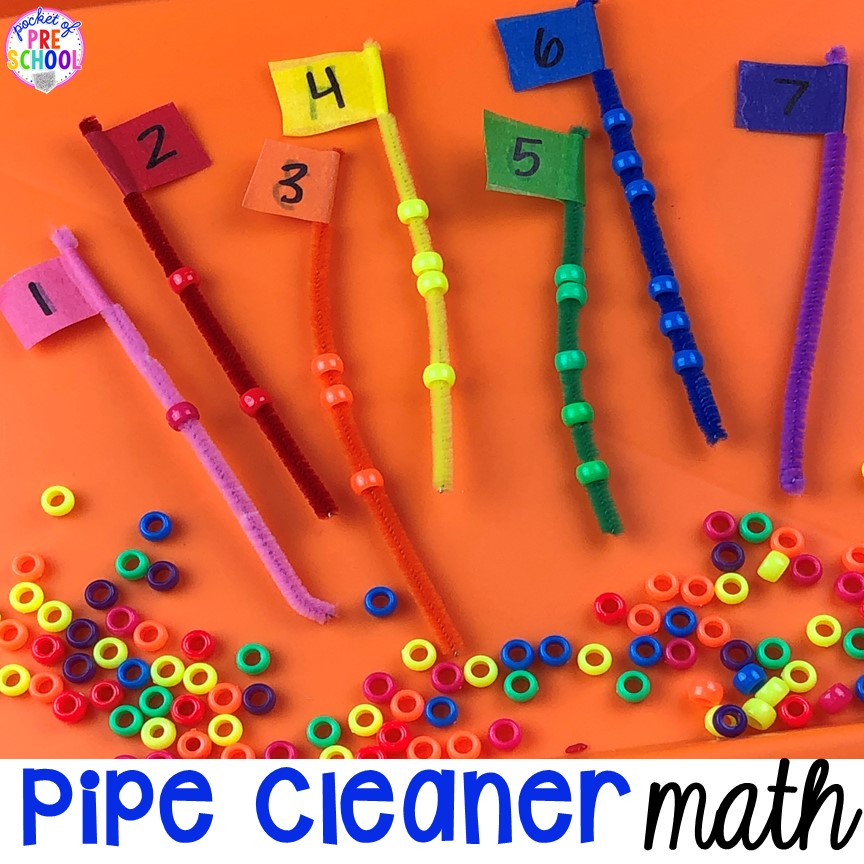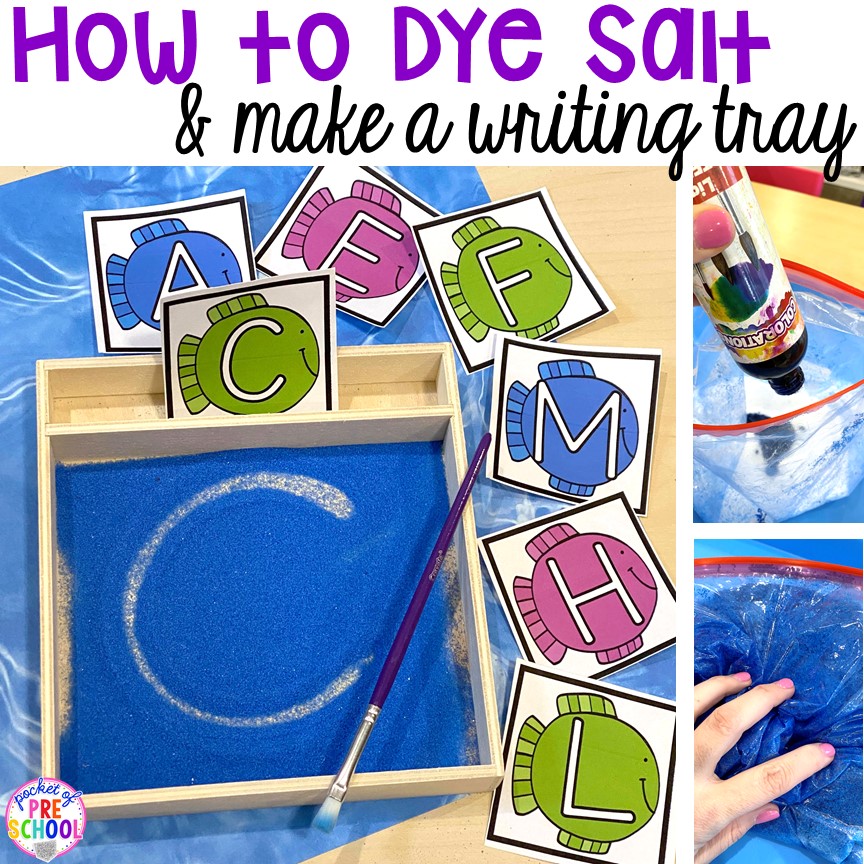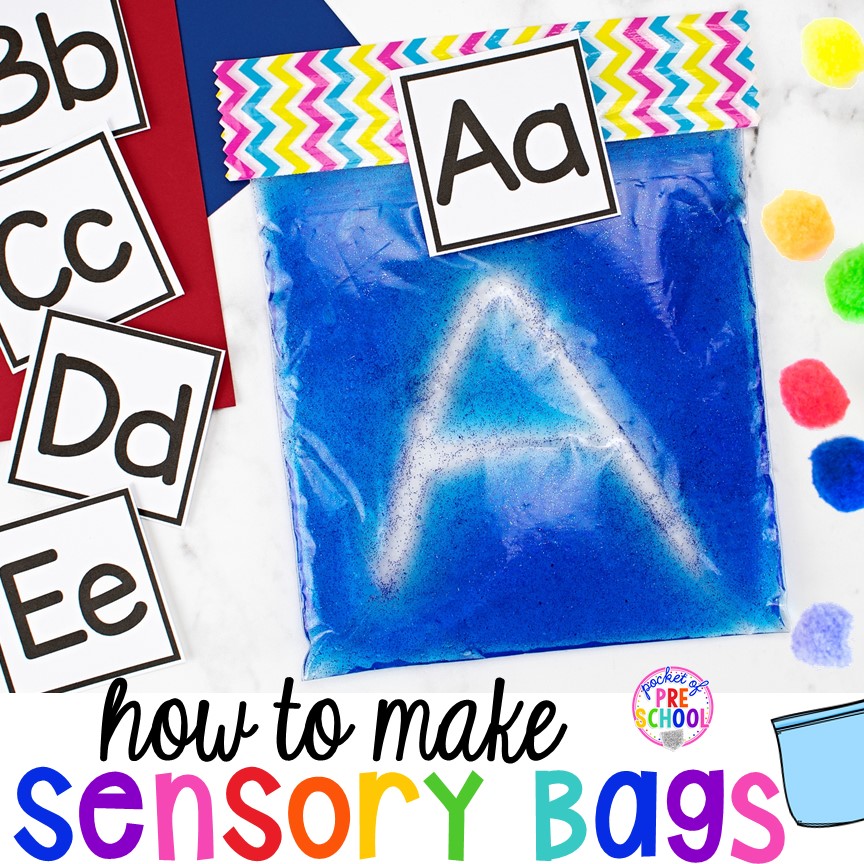
Grab the FREEBIE by entering your email in the box at the bottom of this post. This post contains affiliate links which means I earn a tiny commission when you use my links at no cost to you.
If you want more fine motor activities and printables, check out THESE products from my store.
Scissor Skills Development Continuum
Cutting with scissors is a tricky skill that requires so many skills like overall fine motor strength, hand-eye coordination, bilateral coordination, visual-motor integration, and hand dominance. Just like any other skill, scissor skills will take time to develop and master. You can see the scissor skills developmental sequence below that students will go through as they learn how to cut with scissors. It’s important to do cutting activities at their level, so using scissors isn’t frustrating for students. As a student strengthens their fine motor and visual skills, their scissor skills will strengthen and develop too!
With scissor skills, students will develop…
- hand-eye coordination: use the eyes to visually guide movement for a task such as lacing beads or catching a ball
- bilateral coordination: both hands working together to do a task for example, one hand holds the paper and the other hand cuts with scissors
- visual-motor integration: ability to visually see something, process it, and use their hands appropriate, such as cutting on a line
- hand dominance: the preference of using one hand instead of the other when doing both gross motor and fine motor tasks

Types of Scissors
There are so many types of scissors to choose from. It is important to get quality scissors for your classroom because the cheap scissors often don’t cut well, making students easily frustrated.
Here are my favorite scissors and scissor tools for my classroom:
- Safety Scissors: These scissors will only cut paper and are perfect for younger students who may want to cut things like their hair or clothes.
- Easy-Squeeze Scissors: These are the scissors I like to call “bounce back scissors” because kids just squeeze and the scissors bounce back open! These are great for students who are struggling to open the scissors once they cut or who have weaker fine motor muscles. I always offer these when a student’s hand gets tired from cutting with the blunt tip scissors. This way, they can still cut or do the project without being frustrated with the regular scissors! These scissors are an absolute GAME CHANGER for students just learning how to cut! You NEED these in your classroom.
- Blunt-Tip Scissors: These are the perfect scissors for young students who are learning how to cut. The blunt end makes them safe to use!
- Dough Scissors: These scissors have plastic blades that smoothly cut dough and won’t cut clothes or hair.
- Crinkle-Cut Craft Scissors: These scissors cut different designs like zig zags and scallops.
- Fine Motor Scissor Scoops: Technically, these are not scissors, but they open and close just like scissors! Perfect for use in a sensory table so students can practice the open and close motion without using scissors. My students LOVE playing in the sensory table with these!
- Easy-Punch Design Shapes: These fun punches have different shapes and help strengthen their fine motor muscles. I popped off the bottom plastic piece of my punches so students can easily use the punch shapes for projects!
Lakeshore Coupon! Use my code 2797 to get 20% (off any single non-sale item) and grab some scissors or scissor tools for your classroom.
Coupon valid through Nov. 31, 2021 for one-time use in stores or online. Limit one coupon per customer. Not valid on items with shipping restrictions. Other exclusions may apply. Visit bit.ly/3bbUXIj for details.
Cutting Sensory Bins

Cutting Sensory Bin! Make a cutting bin with ribbon pieces for students to snip! Cutting bins are perfect for students who are just learning how to open and close scissors and who are in the snipping stage. Students can snip the ribbon and place the small pieces back in the bin. I like to put a few pairs of scissors in a cup in the corner of the bin so they don’t get lost in the ribbon or whatever you may put in the bin for students to cut.
Put a piece of tape or stickers on or around the small hole of the scissors as a visual reminder paired with a verbal reminder like “tape to the top.” This will remind them to cut with their thumb up and holding the scissors correctly.

More cutting bins! You can put almost anything in a cutting bin for students to snip and cut. This cutting bin has shredded paper in it from the dollar store, and you can find it in the party section in so many fun colors too.
Try making a cutting bin with:
- shredded paper
- wrapping paper
- bubble wrap
- paper towel tubes
- paper plates (small, large, party plates)
- yarn
- leaves
- nature things (ex: grass, weeds, leaves)
- cooked spaghetti
- packing peanuts
Fun Things to Cut

Cut Play Dough! Use dough scissors or blunt tip scissors to cut play dough. It’s the perfect table time or morning activity! Place a tray with scissors and play dough on it and let the students cut the dough. You can also add scissors to play dough trays and play dough tools basket on the shelf.

Cut Slime! Yes, students can cut slime, and they LOVE it! If you have students who don’t like using scissors, try cutting slime. They will go bonkers! If the slime sticks to the scissors, that’s ok. Just let it dry on the scissors, and then it will peel off easily.

Cut Tape! Students can cut the tape to create a tape collage. Use colored masking tape like we did in this photo, or use washi tape. It can be a bit tricky to cut, so you may need to model how only to unroll a small section of tape to cut. If they unroll a lot of tape at once, it sticks together easily.

Cut straws! The dollar store always has straws for sale in a big pack! In addition, it sometimes has fun straws during different seasons and holidays. Students can make a bracelet by stringing the straw pieces on a pipe cleaner. For extra fun, place rings or beads at the table for students to add to their bracelets too!

Cut Streamers! Crepe paper streamers are bright, colorful, and something different to cut. You can buy streamers from the dollar store, and usually, there are two rolls in one pack.
Cutting Paper Activities & Ideas

Cut Paint Samples! Every time I go to Lowe’s, I always grab a few paint samples to use in the classroom. Sometimes paint samples are very wide, which may be too hard for your students to cut so what you can do is cut them vertically, creating smaller strips.
At first, you want to make strips about 1/2 inch this way; students can cut through the strip with one cut. After they are successful at cutting 1/2 inch strips, make the strips one inch big. As the year goes on and students’ scissors skills get stronger, continue to make the strips longer to make it challenging for your students.

Cut Paper Strips! If you don’t have paint samples, make your own with THIS cutting FREEBIE! Cut the paper to make paper strips the length your students need. It might be half-inch, one-inch, or bigger! Cutting strips is hard because students have to move their other hand down the paper as they cut. When students have to use both sides of their bodies to do a coordinated task, it is called bilateral integration.
>>Grab the FREEBIE by entering your email in the box at the bottom of this blog post!<<
Place stickers or stamp images (using rubber stamps) in between the lines. Students can put the stickers on to give their hands a break from cutting. Pick stickers to match your theme or your student’s interest (ex: Paw Patrol, Thomas the Train, Mickey Mouse).

Fine Motor Journals! Don’t forget to use fine motor journals for cutting activities. These students are cutting two-inch paper strips for this activity since they have moved past the snipping stage. They cut the strip and glue the pieces on the page.
Keep a few different baskets with paper strips of different lengths ready to go for various activities. You can see the blue basket in this photo has the two-inch strips in it. I also have other baskets with half-inch strips in one and one-inch strips in another. Setting out baskets with different-sized strips at different tables is an easy way to differentiate.

Cut Paper Strips! There are so many different kinds of paper you can cut into strips for students to cut. The strips can be of various sizes and lengths, so students can pick the strips they want to cut that are right for them!
Here are some other types of paper (or are like paper) that students can cut:
- wrapping paper
- scrapbook paper
- small paper from note pads
- newspaper
- junk mail
- foam sheets
- cupcake liners
- paper napkins (solid colors, party napkins with a theme)
- wax paper
- foil
- wallpaper samples

Cut Various Types of Lines! Set up a cutting tray or basket with strips that have different types of lines on them. Students can cut on the line and use their other hand to guide the paper as they cut. Some strips are harder than others.
>>Grab the FREEBIE by entering your email in the box at the bottom of this blog post!<<
If students have strong scissor skills, try putting out craft scissors, or “fancy scissors,” as my students like to call them, to make this activity more exciting. They are scissors that cut with fun designs like zig zags and scallops!
These scissors make cutting fun and help build endurance. Our goal is to make their hands super strong to build endurance and cut for longer periods without their hand getting tired.

Cut Shapes! Cutting shapes is hard! Students have to move both hands and turn their wrists as they cut along a line that changes direction. Sometimes students accidentally cut through the shape or cut a piece off. Use tape to piece it back together.
>>Grab the FREEBIE by entering your email in the box at the bottom of this blog post!<<
In baskets, I always keep shapes ready to go for cutting activities, just like I like did above with the paper strips. I can quickly grab the basket for a cutting activity anytime.

Cut Magazines or Store Ads! Now I know people do not get as many magazines anymore, but you can always use store ads or junk mail for these activities. Cut store ads and magazines to create many different projects. If students are struggling cutting out the photos, draw a circle around the item with a thick black marker to help them visually know where to cut. It can be challenging to visually discriminate where to cut on a busy photo.
Here are some projects you can do using magazines, junk mail, or store ads:
- I Like to Eat Lunch Bag Class Book – Click HERE for the FREE printable
- Food Collage on a Paper Plate – Students cut out food they like to eat from grocery store ads and glue it to the plate.
- Feeling Class Book – Students cut out people from magazines and then sort the people by how they are feeling. Each page of the book is a different feeling.
- Letter Collage – Students cut out letters from magazines or ads and glue them to the paper.
- Wish List – Students cut out toys from toy catalogs and glue them to their page. You can use teaching product catalogs like Lakeshore for this activity. The holiday gift guide stores have during the holidays would also work well.
Cutting Arts and Crafts

Cutting Crafts! Make art projects for holidays, seasons, or themes and sneak in scissor skill work. Make a black and white clip art image large on the page and print it out. Students cut out the image and then cut paper strips to fill it in. Add collage items like cotton balls to make it 3D.
>>Grab the FREEBIE by entering your email in the box at the bottom of this blog post!<<

Paper Plate Cutting Craft! You can take any paper plate craft and turn it into a cutting craft. Instead of giving students tissue paper squares or tear paper to cover the plate, have students cut streamers or paper strips to cover the plate. For this Earth Day project, students cut green and blue streamers to make this paper plate Earth.

Eric Carle Art! Make art just like Eric Carle by cutting up painted paper. The students in this photo were pre-k students in the spring, so their designs are very detailed and precise. My three-year-olds made gorgeous Eric Carle art too, but it was more a collage of larger shapes or one big image. Both age groups cut at their unique level and made amazing art!
To make the painted paper, paint the paper using a few colors. Next, add texture with forks or other kitchen tools. Lastly, let it dry, and now you have tons of gorgeous painted paper to cut!
Other Tools to Help Develop Scissor Skills

Scissor Scoops! These are not scissors but open and close, just like scissors! This activity is perfect for kiddos who don’t like to use scissors or get frustrated easily. Toss them in any sensory table so students can practice the open and close motion without using scissors.

Paper Punches! These Easy-Punch Design Shapes punches have different shapes and help strengthen their fine motor muscles. I have a tub in my art center with paper punches that students can use anytime for art projects. In addition to using them in the art center, these punches are also fun for table time! Place the punches on a tray with strips of paper for a fun fine motor activity.
Students need strong hands to cut with scissors making it just as important to provide fine motor activities that strengthen their hands, wrists, and fingers. If students have weak fine motor, their hands will get tired easily, or it will be frustrating to cut thicker things.
Here are some other tools you can add to sensory tables, math activities, literacy activities, or pretend play that will strengthen their hand and wrist muscles:
- tweezers
- clothespins
- play dough
- slime
- droppers or small eye droppers
- small blocks that connect such as Legos, linking cubes, pipe builders, straw builders
- lacing beads
- locking, snapping, or zipping activities or puzzles such as Letter Locks, snap letter blocks or snap dinos
- math chains
- pegs
- hammering activities
- slicing food (real or pretend)
- ripping paper art or activities
Those are my go-to cutting and scissor skill activities that my students LOVE! If you try them in your classroom, tag me on social media or in the Pocket of Preschool Facebook Group because I would LOVE to see them.
>>Grab the FREEBIE by entering your email in the box below!<<
If you want to check out more fine motor ideas, check out these posts by clicking on the image!
If you LOVE these activities, pin this image!
